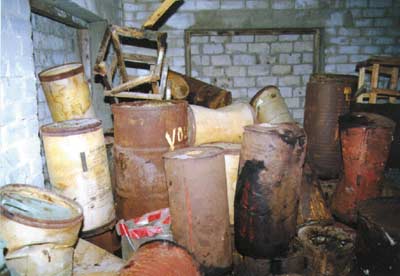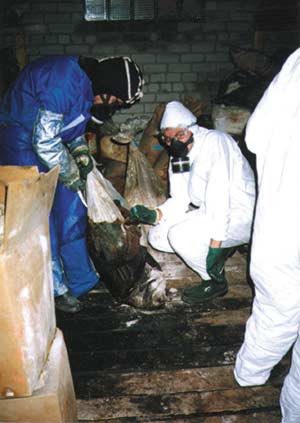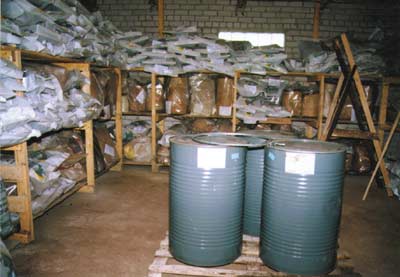Danish - Lithuanian Environmental Co-operation 1991-2000
Chapter 12
Chemicals and genetically modified organisms - GMOs
Projects described:
Management of unused and
obsoleted pesticides
The control of chemicals and GMOs is a challenge that applies to the global society rather than the national scenes, and in the recently revised DANCEE strategy, more emphasis is put on the field of control of chemicals.
The DANCEE programme has supported the mapping out and labelling of pesticides in old and obsolete storage facilities. Apart from that, only few activities have been carried out so far in relation to chemicals and genetically modified organisms.
The control of chemicals and GMOs is a challenge that applies to the global society rather than the national scenes, and in the recently revised DANCEE strategy, more emphasis is put on the field of control of chemicals.
It is also expected that greater emphasis will be reflected in the future DANCEE activities in Lithuania.
Hence, more activities in the sector of chemicals and GMOs are planned in relation to EU approximation in the period of the country programme. In particular, attention will be to the development of legislation to ensure full harmonisation, building up of capacity in the Lithuanian Ministry of Environment to implement the EU chemical legislation, assessment of investment needs in the public sector for implementation of the new legislation and development of pilot schemes for industries.
Management of unused and obsoleted pesticides
The former centralised pesticide supply system was poorly administered and resulted in considerable amounts of outdated partly known pesticides that accumulated in several pesticide storage facilities throughout Lithuania. Most of the pesticides were hazardous and due to poor storage conditions, they posed a risk to the public health and environment.
An inventory carried out some years ago provided a figure of 953 tons of pesticide products accumulated in 296 storage sites throughout the country. Part of the products in these storage sites was unknown due to poor attention on proper handling and storage conditions, large quantities of packaging and damaged containers.
The objective
The objective of the project is to assist the Government of Lithuania in establishing an action plan for safe management of unused pesticides. The action plan covers identification, re-packing, re-labeling, and treatment/disposal of unused pesticides. The application of the action plan has been demonstrated in practice and investigation and remedial work has been carried out in four selected pilot storage facilities.

Pesticide storage before analysis, labelling and clean up.
The procedure
The inventory revealed that approximately twice the number of pesticide active ingredients than expected was present in the storage facilities. To identify unknown pesticides, a mobile laboratory from the Danish Technological Institute was provided for onsite analytical work. Prioritization of pesticide storage facilities has been based on assessment of technical storage conditions. For all storage facilities, relevant treatment and disposal methods have been outlined. Site specific activity plans have been worked out for four pilot storage facilities. They included specific safety measures, establishment of temporary working place, procedures for repackaging, handling of spillage, removal of working place, procedure for sampling and relabeling.

The DANCEE programme has supported the sorting, labelling and safe storage of obsolete pesticides in Lithuania.
The environmental result
The project has provided the Government of Lithuania with recommendations on feasible treatment and disposal methods regarding unused pesticides. Some of pesticide products were proposed for agricultural use. For destruction of organic chemical compounds including pesticides, the sole universal method is incineration. Until this treatment option is available, temporary storage of unused pesticides in warehouses is recommended as a solution although allowed only for a limited period of time.

Pesticide storage before analysis, labelling and clean up.